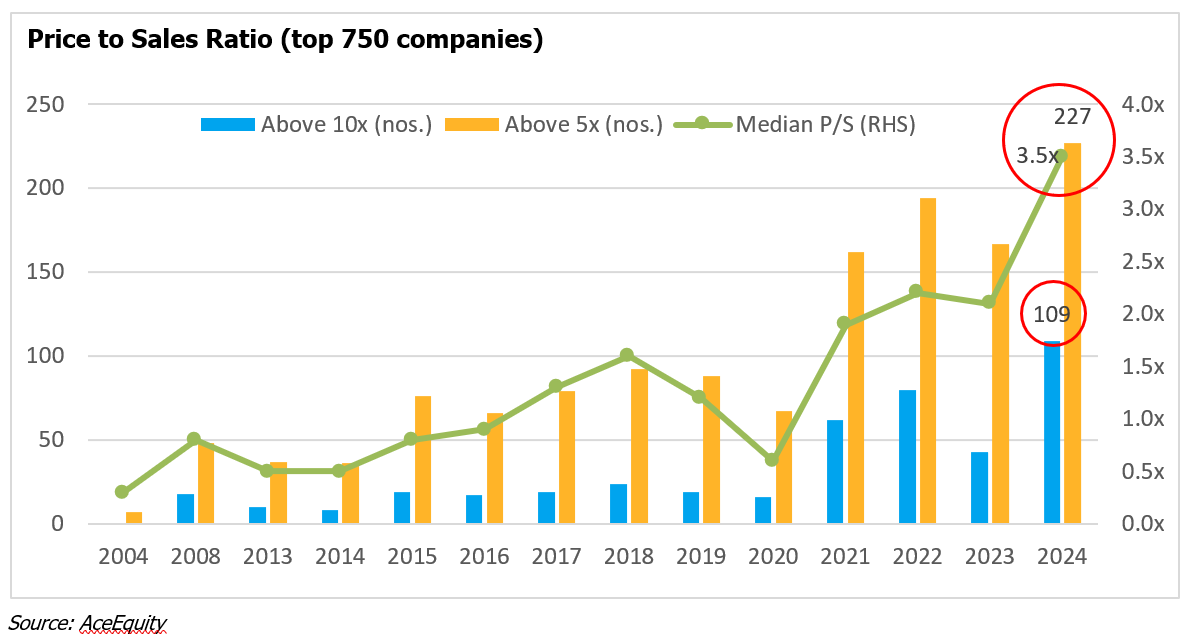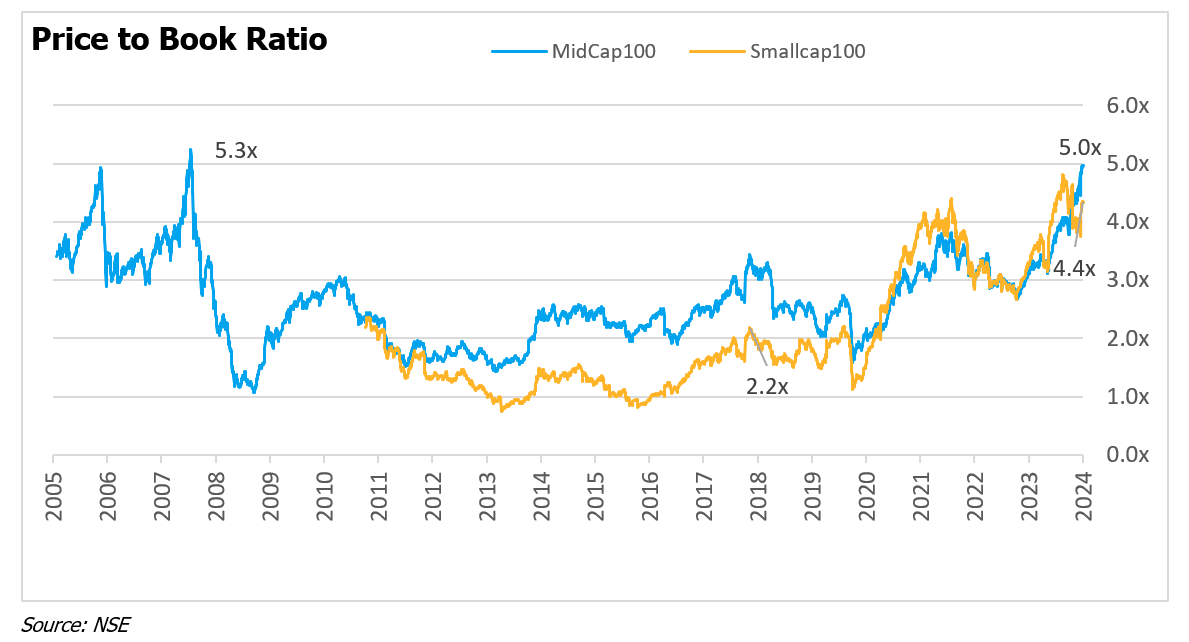EXECUTIVE SUMMARY
|
Dear Fellow Investors,
15%+ earnings growth, not built into stock prices
In near term, stock price movements are often poor arbiter of investment actions. In a rising market, a poor investment choice may deliver returns, and caution may seem unwise. Conversely, in a falling market, a good investment action may continue seeing price fall, or aggression may seem bewildering.
It may be better, instead, to judge investment decisions by looking at fundamental improvements. Free cash flow is the ultimate contributing metric to the value of a company. Free cash flow = cash earnings – cash investments. However, for a growing company free cash flow can be volatile when looked at annually and may not give a clear picture in some years. Also, free cash flow is complicated to calculate for financial firms.
A simpler but crude alternative measure can be earnings growth. Over time, earnings growth of good companies matches their free cash flow growth. Earnings, however, can be messy – distorted by cycles, management tricks, accounting quirks (lease accounting for example), or one-offs. In absence of any other objective, easy and homogenous measure comparable across companies, we need to live with its limitations and make some adjustments to normalise the earnings power. Further, studying multi-year earnings may be more appropriate.
Our benchmark for success is sustained adjusted earnings CAGR (compounded annual growth rate) of at least 15%. In light of India’s expected nominal GDP growth of 9%-10%, this seems a reasonably ambitious goal. But growth alone isn’t enough—we need to buy that growth at prices that don’t already assume it. A basic discounted cash flow working, after gaining clear understanding of the business and its key drivers, can help decode that.
If markets are efficient and most companies well studied, why would this happen? Mostly due to three reasons – Temporary hardship (higher chances), small untracked companies (lower chances, today), or underappreciated lucky break for companies (elevate earnings power; tough to pick in advance).
This brings us to the key investment challenge today. A large number of companies today are pricing in a much higher future earnings growth expectations in comparison to (a) what they have delivered in past and (b) their future earnings potential. This dichotomy is sustaining due to continued buying from retail investors at every levels. But, if history and valuation math is a guide, the two metrics – earnings growth and share price growth – usually converge.
Whenever we hear optimistic and bullish thesis about any sector or company, it may be prudent to pause and ask – “isn’t this already built into the price?”. Only if the answer is a convincing no, should one proceed to next steps.
Amid this challenge, we continue to remain selective in our purchases. Our investing efforts aim maintaining a 15%+ earnings growth without overpaying. We have been reporting earnings per unit, portfolio P/E and portfolio turnover in these letters since inception to help you evaluate performance holistically in the light of the above goal. Neutral stance stays.
A. PERFORMANCE
A1. Statutory PMS Performance Disclosure
| Year Ended | CED Long Term Focused Value (PMS) | BSE 500 TRI (Benchmark) | Difference | ||
| Return | Avg. Cash Eq. Bal. | Return | Trailing P/E | ||
| YTD FY26 | 17.3% | 20.4% | 7.2% | 24.4x | +10.1% |
| FY 2025 | 10.3% | 21.0% | 6.0% | 23.4x | +4.3% |
| FY 2024 | 29.2% | 26.1% | 40.2% | 26.2x | -11.0% |
| FY 2023 | -4.3% | 30.0% | -0.9% | 22.3x | -3.4% |
| FY 2022 | 14.9% | 38.5% | 22.3% | 25.0x | -7.4% |
| FY 2021 | 48.5% | 29.0% | 78.6% | 38.0x | -30.1% |
| FY 2020* | -9.5% | 23.0% | -23.4% | 18.3x | +13.9% |
| Since Inception(6Y) | 15.7% | 27.9% | 17.0% | -1.3% | |
| *From Jul 24, 2019; ‘Since inception’ performance is annualised; Note: As required by SEBI, the returns are calculated on time weighted average (NAV) basis. The returns are NET OF ALL EXPENSES AND FEES. The returns pertain to ENTIRE portfolio of our one and only strategy. Individual investor returns may vary from above owing to different investment dates. Annual returns are audited but not verified by SEBI. | |||||
Quality and valuation as guides
Two primary attributes we look for while investing are quality and valuation. If either is missing, we’ve learned it’s better to wait than to compromise and risk capital. Over the past four years, valuations were rarely attractive, so we held back, keeping on average more than 27% in cash and equivalents. In a roaring bull market, that caution naturally led to relative underperformance between FY21–FY24. That said, at around 15%, our absolute return remained healthy during FY21-24, even if it lagged the benchmark.
The past year has brought a shift: markets have become more discerning. Without changing our process materially and continuing our preference for both quality and valuation, the gap has partly closed. Of course, it would be wonderful if we could predict the rare moments when compromising on quality and/or valuations might pay off. But in reality, such timing is near impossible. The safer and more rewarding path is to stay disciplined: demand both good quality and reasonable valuation. Over time, this stance delivers.
A2. Underlying business performance
| Past Twelve Months | Earnings per unit (EPU)2 | FY 2026 EPU (expected) |
| Jun 2025 | 10.01 | 10.0-10.83 |
| Mar 2025 (Previous Quarter) | 9.3 | 10.0-10.83 |
| Jun 2025 (Previous Year) | 8.8 | |
| Annual Change | 13.6% | |
| CAGR since inception (Jun 2019) | 14.9% | |
| 1 Last four quarters ending Jun 2025. Results of Sep quarter are declared by Nov only. 2 EPU = Total normalised earnings accruing to the aggregate portfolio divided by units outstanding. 3 Please note: the forward earnings per unit (EPU) are conservative estimates of our expectation of future earnings of underlying companies. In past we have been wrong – often by wide margin – in our estimates and there is a risk that we are wrong about the forward EPU reported to you above. | ||
Trailing Earnings: Trailing twelve months Earnings Per Unit (EPU) of underlying companies, grew by 13.6% (including effects of cash equivalents that earn ~6%).
1-Yr Forward Earnings: We retain the guidance range of Rs 10.0-10.8 for the expected Earnings per Unit for FY26.
A3. Underlying portfolio parameters
| Sep 2025 | Trailing P/E | Forward P/E | Portfolio RoIC | Portfolio Turnover1 |
| CED LTFV (PMS) | 24.8x | 22.9x-24.8x | 37.0%3 | 8.3% |
| BSE 500 | 24.4x2 | – | 17.4%2 | – |
| 1 ‘sale of equity shares’ divided by ‘average portfolio value’ during the year to date period. 2Source: Asia Index. 3Portfolio Return on Invested Capital (RoIC) is on core equity positions. For BSE 500 index we share the RoE (Return on Equity) | ||||
B. DETAILS ON PERFORMANCE
B1. MISTAKES AND LEARNINGS
We did not discover any new mistakes this quarter.
B2. MAJOR PORTFOLIO CHANGES
Bought: We added further to four of our existing positions. One of the positions graduated to becoming a major position whose initiating thesis was shared with investors.
Sold: We exited from three positions mainly due to higher valuations.
B4. FLOWS AND SENTIMENTS
Domestic flows remain strong, with retail investors actively participating in both mutual funds and IPOs. The concern is that much of this money is chasing smaller and/or riskier companies. On the other side, promoters, private equity investors, and foreign funds are using this retail demand to exit at record valuations.
The prevailing counter-argument to caution is the so-called “buy the dip” mentality, or what some call the “retail put”. The logic goes: if money keeps pouring in, won’t prices just keep rising? The problem is that flows are notoriously unpredictable. They are driven more by sentiment than fundamentals, and history shows that shocks often appear when least expected. When that happens, inflows can quickly reverse.
Until then, though, “buy the dip” rules the day. Take the recent example of US tariffs: Washington has imposed a 50% tariff on Indian goods and a $100,000 one-time fee on H1B visas. Many believe these are just bargaining tactics and expect them to be rolled back. But if they aren’t, the second order consequences for India’s economy and jobs could be meaningful — risks that the market is currently ignoring.
GST rate cuts will approximately lead to 8-10% savings to consumers. Income tax cuts announced in the Union Buglet earlier are further expected to add to the savings of the middle/ higher middle-class consumers. How much of this will be used to repay existing borrowings (Indian consumers have been besieged by over borrowing), and how much will spur spending will be clear in next few quarters.
C. OTHER THOUGHTS
Getting more by doing less
Capital gains taxes in India have risen to 12.5% and 20% for long term and short term respectively. Add to it transaction charges or around 1% and average cost of frequent transacting has increased. Today there is strong case for holding longer to improve net returns.
We ran a simple exercise to see the impact. Assume a stock compounds at 15% annually:
- Scenario A: Hold it for 10 years straight, then sell.
- Scenario B: Sell every 367 days (just after it qualifies as long-term) and reinvest.
At the end of 10 years, Scenario A is worth 24% more than Scenario B. Stretch it to 20 years, and the gap widens to 54%.
Yes, this is too simplistic. Often changes in company’s fundamentals or valuations warrant trimming. But the broader point is that lesser activity is more valuable in today’s environment given that capital gains taxes are highest in the recent history (and are unlikely to come down). Therefore, choosing investments that can be held for longer periods of time and avoiding needless turnover adds to overall returns.
***
As always, gratitude for your trust and patience. Kindly do share your thoughts, if any. Your feedback helps us improve our services to you!
Kind regards
Sumit Sarda
Partner and Portfolio Manager
————————————————————————————————————————————————-
Disclaimer: Compound Everyday Capital Management LLP is SEBI registered Portfolio Manager with registration number INP 000006633. Past performance is not necessarily indicative of future results. All information provided herein is for informational purposes only and should not be deemed as a recommendation to buy or sell securities. This transmission is confidential and may not be redistributed without the express written consent of Compound Everyday Capital Management LLP and does not constitute an offer to sell or the solicitation of an offer to purchase any security or investment product. Reference to an index does not imply that the firm will achieve returns, volatility, or other results similar to the index.



